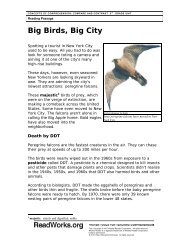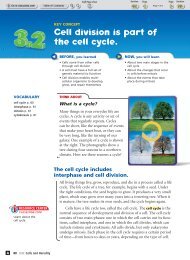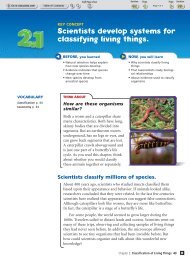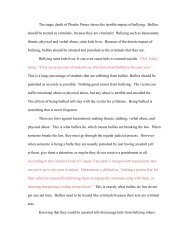Different cells perform various functions.
Different cells perform various functions.
Different cells perform various functions.
You also want an ePaper? Increase the reach of your titles
YUMPU automatically turns print PDFs into web optimized ePapers that Google loves.
EA<br />
VOCABULARY<br />
specialization p. 28<br />
tissue p. 29<br />
organ p. 30<br />
MAIN IDEA WEB<br />
Make a web of the important<br />
terms and details<br />
about the main idea:<br />
Organisms can be classified<br />
by their cell type.<br />
26 Unit: Cells and Heredity<br />
KEY CONCEPT<br />
<strong>Different</strong> <strong>cells</strong> <strong>perform</strong><br />
<strong>various</strong> <strong>functions</strong>.<br />
BEFORE, you learned<br />
• Modern microscopes reveal<br />
details of cell structures<br />
• Some <strong>cells</strong> are prokaryotic and<br />
some are eukaryotic<br />
•Plant and animal <strong>cells</strong> have<br />
similarities and differences<br />
EXPLORE Specialization<br />
How do roots differ from leaves?<br />
PROCEDURE<br />
1<br />
2<br />
3<br />
Soak the grass plant in a cup of water to clean<br />
away any dirt.<br />
Compare the color of the roots with the<br />
color of the blades or leaves. Record your<br />
observations.<br />
Wash your hands when you have finished.<br />
WHAT DO YOU THINK?<br />
• How does the color of the grass roots compare<br />
with that of the grass blades?<br />
• Chloroplasts contain a chemical that gives<br />
leaves their green color. What does this suggest<br />
to you about the <strong>functions</strong> of the grass blades<br />
and roots?<br />
NOW, you will learn<br />
• How organisms are classified<br />
into three domains<br />
• About specialization in multicellular<br />
organisms<br />
• How <strong>cells</strong>, tissues, and organs<br />
are organized<br />
MATERIALS<br />
•grass plants<br />
• cup<br />
•water<br />
Organisms can be classified by their<br />
cell type.<br />
Look around you at this moment. The living organisms you see may<br />
number 10, 20, 100, or 1000, depending on where you are. What you<br />
are not seeing, but what is also there, is a huge number of unicellular<br />
organisms. For example, there are at least 2–3 million bacteria living<br />
on each square centimeter of your skin.<br />
Most of the organisms alive on Earth today are made of a single<br />
cell. One of the most interesting scientific discoveries made recently<br />
had to do with a group of unicellular organisms. These organisms<br />
were found living where no one expected to find any life at all.
Archaea and Bacteria<br />
In the early 1980s, scientists discovered unicellular organisms living<br />
in rather extreme environments. Some were living deep in the ocean,<br />
at thermal vents where there is extreme heat and no oxygen. Others<br />
were found in the salty waters of the Great Salt Lake and in the hot<br />
sulfur springs of Yellowstone Park.<br />
At first, these organisms were referred to as archaebacteria. The<br />
organisms were similar in appearance to bacteria. The prefix archae<br />
comes from a Greek word that means “ancient.” Many of these<br />
organisms live in environments that are like the environments of<br />
ancient Earth.<br />
archaea<br />
thermal vent<br />
It took a while for scientists to realize that these organisms that<br />
looked like bacteria were genetically very different from bacteria.<br />
Scientists decided to establish a separate category for them, a domain<br />
called Archaea (AHR-kee-uh). A domain is a broad category of living<br />
things that is based on characteristics of their <strong>cells</strong>. Scientists have<br />
identified three domains. Bacteria are classified in the domain<br />
Bacteria. A third domain includes organisms with eukaryotic <strong>cells</strong>.<br />
Organisms that belong to the domains Bacteria and Archaea are<br />
similar in some important ways. They are prokaryotes, which are unicelluar<br />
organisms made of prokarytic <strong>cells</strong>. Their cytoplasm contains<br />
ribosomes but no organelles, so the structure of a prokaryote is simple.<br />
Another feature of a prokaryote is a tough cell wall that protects<br />
the organism.<br />
Check Your Reading Why did scientists decide to establish separate domains for<br />
archaea and bacteria?<br />
reminder<br />
The genetic material in<br />
a prokaryotic cell is not<br />
enclosed in a nucleus. In<br />
eukaryotic <strong>cells</strong> genetic<br />
material is stored in a<br />
nucleus.<br />
Archaea are prokaryotic<br />
organisms that can live in<br />
extreme environments like<br />
these thermal vents. In a<br />
thermal vent, temperatures<br />
can reach 600 degrees<br />
Celsius.<br />
RESOURCE CENTER<br />
CLASSZONE.COM<br />
Learn more about<br />
unicellular organisms.<br />
Chapter 1: The Cell 27<br />
EA
EA<br />
VOCABULARY<br />
Remember to add a four<br />
square for specialization to<br />
your notebook.<br />
28 Unit: Cells and Heredity<br />
Eukarya<br />
The third domain is the domain Eukarya. Organisms in this domain<br />
have <strong>cells</strong> with a nucleus. This domain includes almost all the multicellular<br />
organisms on Earth: plants, animals, and fungi. It also<br />
includes many unicellular organisms called protists. The <strong>cells</strong> of unicellular<br />
eukaryotes are more complex in structure and larger than the<br />
<strong>cells</strong> of prokaryotes.<br />
Check Your Reading How are eukaryotes different from prokaryotes?<br />
The paramecium is one of the most complex<br />
of all unicellular eukaryotes. Its body is lined<br />
with hairlike strands, called cilia<br />
(SIHL-ee-uh), that allow it to move.<br />
It has dartlike structures that carry<br />
a substance used in healing and,<br />
perhaps, defense. Along the outside<br />
of the cell is a long oral groove<br />
lined with cilia that leads to a<br />
mouth pore. In addition to a<br />
nucleus, the cell of a paramecium<br />
has organelles that enable it to<br />
digest food and remove water and<br />
wastes. The paramecium has all it<br />
needs to live as a single cell. By comparison,<br />
in most multicellular eukaryotes, no<br />
individual cell can survive on its own.<br />
Label oral groove<br />
Cells in multicellular organisms specialize.<br />
Most multicellular organisms consist of many different types of <strong>cells</strong><br />
that do different jobs. For example, most animals have blood <strong>cells</strong>,<br />
nerve <strong>cells</strong>, and muscle <strong>cells</strong>. The <strong>cells</strong> are specialized.<br />
of <strong>cells</strong> means that specific <strong>cells</strong> <strong>perform</strong> specific <strong>functions</strong>. This specialization<br />
is why a single cell from a multicellular organism cannot<br />
survive on its own. A blood cell can help you fight infection or deliver<br />
oxygen to your muscles, but it cannot cause your body to move as a<br />
muscle cell can. Plants have <strong>cells</strong> that function in photosynthesis, and<br />
other <strong>cells</strong> that draw water from the soil, and still others that function<br />
mainly to support the plant’s weight.<br />
Check Your Reading What does it mean for a cell to be specialized?<br />
paramecium 1000<br />
Label mouth pore<br />
cilia<br />
Specialization
Specialization<br />
A fully grown salamander has many specialized <strong>cells</strong>.<br />
embryo<br />
1 2 3<br />
A salamander, like all multicellular<br />
organisms, begins life as an<br />
egg. After fertilization, the egg<br />
develops into an embryo.<br />
larva<br />
As the <strong>cells</strong> divide, they begin<br />
to specialize. The amount of<br />
specialization depends on the<br />
complexity of the organism.<br />
A multicellular organism is a community<br />
of <strong>cells</strong>.<br />
Cells in a multicellular organism are specialized. The ways in which<br />
the <strong>cells</strong> work together and interact depend on the organism. You can<br />
think of the <strong>cells</strong> of an organism as members of a community. The size<br />
and complexity of the community differ from organism to organism.<br />
A sponge is an animal that is fairly simple in its organization. It<br />
spends its life attached to the ocean floor, filtering food and other<br />
nutrients from the water. Like all animals, the sponge is organized at<br />
a cellular level. <strong>Different</strong> types of <strong>cells</strong> in its body <strong>perform</strong> different<br />
<strong>functions</strong>. For example, certain <strong>cells</strong> take in food, and other <strong>cells</strong><br />
digest it. However, <strong>cells</strong> in a sponge are not very highly specialized.<br />
A piece broken from a living sponge will actually regenerate itself as<br />
new <strong>cells</strong> replace the lost ones.<br />
In more complex organisms, such as plants and animals, <strong>cells</strong> are<br />
not only specialized but grouped together in tissues. A tissue is a<br />
group of similar <strong>cells</strong> that are organized to do a specific job. If you<br />
look at your hand, you will see the top layer of tissue in your skin.<br />
Humans have two layers of skin tissue, layered one on top of the<br />
other. Together these skin tissues provide protection and support.<br />
Check Your Reading In what way is a tissue an organization of <strong>cells</strong>?<br />
salamander<br />
A salamander’s body has many<br />
specialized <strong>cells</strong>. These include<br />
skin <strong>cells</strong>, blood <strong>cells</strong>, bone <strong>cells</strong>,<br />
muscle <strong>cells</strong>, and nerve <strong>cells</strong>.<br />
Chapter 1: The Cell 29<br />
EA
EA<br />
Levels of Organization<br />
Levels of organization in multicellular organisms include <strong>cells</strong>,<br />
tissues, organs, organ systems, and the organism itself.<br />
Plant cell<br />
Tissue<br />
Organ: leaf<br />
Organ system:<br />
leaves, stems, roots<br />
30 Unit: Cells and Heredity<br />
Organism: lilac tree<br />
Animal cell<br />
Tissue<br />
Organ: eye<br />
Organ system:<br />
eyes, brain, nerves<br />
Organism: tarsier<br />
<strong>Different</strong> tissues working together to <strong>perform</strong> a particular function<br />
represent another level of organization, the organ. The eye is an organ<br />
that <strong>functions</strong> with the tarsier’s brain to allow sight. A leaf is an organ<br />
that provides a plant with energy and materials. It has tissue that<br />
brings in water and nutrients, tissue that uses the Sun’s energy to<br />
make sugar, and tissue that moves sugar to other parts of the plant.<br />
Check Your Reading What is the relationship between tissues and organs?
<strong>Different</strong> organs and tissues working together form an organ<br />
system. An organism may have only a few organ systems. The organ<br />
systems of plants include roots, stems, and leaves. Other organisms<br />
have many organ systems. Humans have 11 major organ systems,<br />
made up of about 40 organs and over 200 types of tissue. The human<br />
nervous system, for example, includes the brain, the spinal cord,<br />
nerves, and sensory organs, such as the ears and eyes.<br />
An organism itself represents the highest level of organization.<br />
It is at this level that we see all the characteristics we associate with<br />
life. If an organism is a complex organism—a human—for example,<br />
it will consist of trillions of <strong>cells</strong> grouped into tissues, organs, and<br />
organ systems. However, a simple organism, like a sponge, meets its<br />
needs with a body made up of only a few types of specialized <strong>cells</strong>.<br />
Check Your Reading What level of organization is an organism? What do we see at<br />
this level of organization?<br />
What are some of the limitations of using<br />
a model to represent a cell?<br />
PROCEDURE<br />
1<br />
2<br />
3<br />
4<br />
Work with a partner to choose a type of cell to model and to<br />
determine the types of organelles to include.<br />
Using the poster board as a base, construct the model from<br />
available supplies. Make the model as accurate as you can.<br />
Use a marker to label each organelle, and include a description<br />
of its function.<br />
Compare your cell model with those made by your classmates.<br />
WHAT DO YOU THINK?<br />
•What are some of the limitations of using<br />
a model to represent a cell?<br />
•What are some of the benefits of making<br />
a three-dimensional model of a cell?<br />
CHALLENGE Think of something to<br />
which you might compare the activities of<br />
a cell—perhaps the activities of a factory<br />
or a school. Add labels to your model to<br />
show how the comparison applies to each<br />
of the cell’s structures.<br />
Cell Models<br />
SKILL FOCUS<br />
Making models<br />
MATERIALS<br />
•craft supplies<br />
• scissors<br />
•glue<br />
• poster board<br />
• markers<br />
TIME<br />
30 minutes<br />
Chapter 1: The Cell 31<br />
EA
EA<br />
Scientific Models<br />
Scientists use<br />
several different<br />
types of models.<br />
Watson and Crick used a model made<br />
from wire and tin.<br />
KEY CONCEPTS<br />
1. What are the three domains,<br />
and what type of <strong>cells</strong> do<br />
the organisms in each domain<br />
have?<br />
2. Define specialization in your<br />
own words.<br />
3. Describe the levels of organization<br />
in a tree.<br />
32 Unit: Cells and Heredity<br />
Scientists use models to study <strong>cells</strong>.<br />
Any drawing or photograph on a flat page is two-dimensional. In<br />
addition, diagrams of <strong>cells</strong> are often simplified to make them easier<br />
to understand. If you look at plant or animal<br />
<strong>cells</strong> under a microscope, you will notice some<br />
differences between real <strong>cells</strong> and the diagrams<br />
on page 22. In order to study cell structures<br />
and their <strong>functions</strong>, scientists use many types<br />
of models, including three-dimensional models.<br />
One of the most important discoveries in science<br />
involved the use of models.<br />
CRITICAL THINKING<br />
DNA is the genetic material common to all<br />
<strong>cells</strong>. (You will read more about the structure and<br />
function of DNA later in this unit.) In the early<br />
1950s, scientists had a good idea what DNA was<br />
made up of. The problem was that they could not<br />
figure out how all the pieces of the molecule fit<br />
together.<br />
A scientist named Rosalind Franklin used xrays<br />
to produce images of DNA. The x-ray<br />
provided an important clue as to the shape of the<br />
molecule. Two other scientists, James Watson and<br />
Francis Crick, were then able to put together a<br />
three-dimensional model of DNA and present it<br />
to the world in 1953.<br />
Today’s scientists have many different tools for making<br />
models. The images at the left show a computer model of<br />
DNA along with Watson and Crick’s famous model.<br />
4. Synthesize In what way<br />
does a specialized cell in a<br />
multicellular organism differ<br />
from the cell of a unicellular<br />
organism?<br />
5. Compare and Contrast<br />
How is a model similar to the<br />
real object it represents? How<br />
is it different?<br />
CHALLENGE<br />
6. Evaluate The organism below<br />
is called Chlamydomonas.<br />
What domain does it belong<br />
to, and what do the internal<br />
structures tell you about it?<br />
cell wall<br />
chloroplast<br />
flagella (allow movement)<br />
cell membrane<br />
nucleus<br />
mitochondrion

















